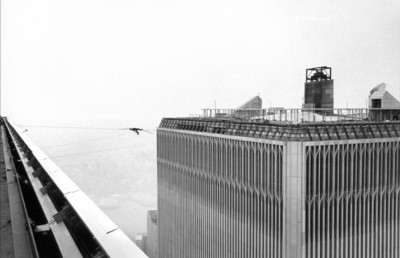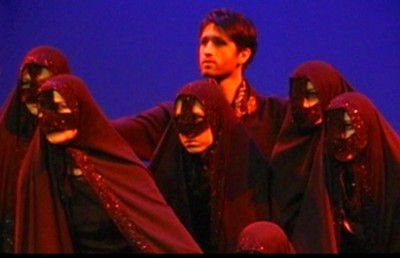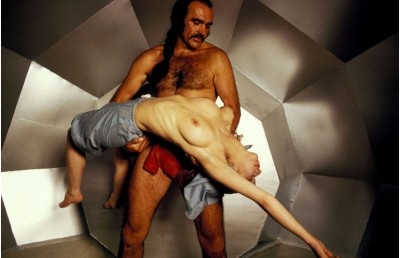Tokyo Sonata: Flirting with the Fantastic
Kiyoshi Kurosawa, 2008
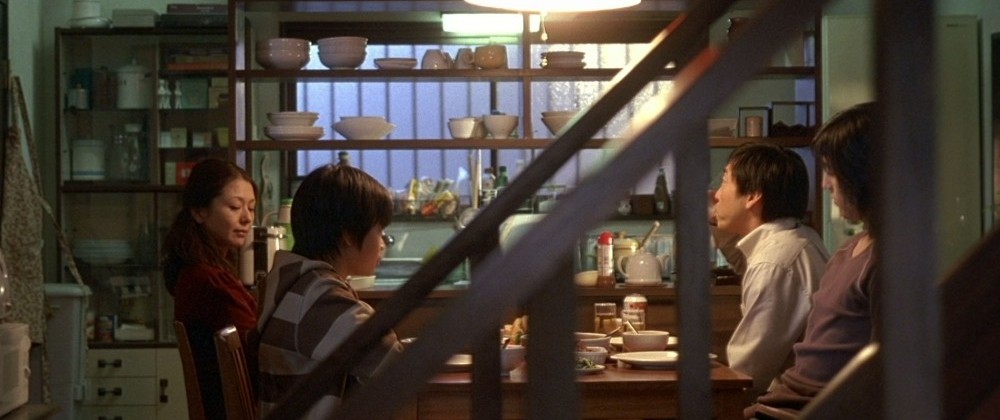
Kiyoshi Kurosawa has quietly (appropriately enough, given his aesthetic) become the master of the slow burn horror. His 1997 Cure marked his entry into the broad parameters of what could be called horror. With Cure Kurosawa tackled the serial killer film but steered from the moral or narrative clarity of predecessors like Seven or Silence of the Lambs. In Cure a series of bizarre killings take place where each victim is left scarred with an X on their chest (homage to Hawks’ Scarface?), and the killers are found with no memory of the murder or possible motive. The disconnected killings are eventually tied to a disturbed young man who seems to have the power to hypnotize people into killing. Kurosawa is less interested in solving the crimes or understanding them, than he is in tapping into the psychological underpinnings that the crimes bring out of the detective investigating the crimes, Takabe (played by Kurosawa’s favorite actor, Koji Yakusho). Kurosawa’s understated style (long takes, minimal use of music, ambient electronic sounds, autumnal lighting) builds toward an atmosphere of dread that grows as much from the underlying themes of identity loss, urban ennui, and alienation, as the actual murders. Kurosawa followed Cure with a slew of similarly themed and styled horror films, sometimes adding a hint of the supernatural. They are Charisma (1999), Seance (2000), Pulse (2001), Bright Future (2003), Doppelganger (2003), Loft (2005), and Retribution (2006). Although Kurosawa is rightly figured into the J-horror phenomena and is arguably its greatest practitioner –Cure was made one year before the breakthrough J-horror film, Hideo Nakata’s Ring??– his horror films don’t fit perfectly into the J-horror mold, which perhaps explains why only one of his films has been turned into a US remake, ??Pulse. The point is not that his films are not frightening in the same way as J-horror (they are), but that they seem to have more invested in the human condition (lack of communication, breakdown of the family, loss of identity, technological dependency, alienation from nature, etc.) than the average J-horror film. Some of the other great J-horror films also touch on these issues (Ringu and Inugami, for example), but if Michelangelo Antonioni had been born in Japan forty years later and made J-horror films, they would be like Kurosawa’s!
With Tokyo Sonata Kiyoshi Kurosawa takes a partial step back from his traditionally contemplative horror Kammerspeils for the genre that the great Yasujiro Ozu made most of his films in, the gendaigeki (films dealing with contemporary life). In a sense, Tokyo Sonata is a reverberation on Ozu’s classic gendaigeki, Tokyo Story (1953), which looked at the changing social values in post-world war 2 Japan, using the family as a microcosm of the strains between tradition (a mother and father living in Onomichi) and modernity (their married children living in Tokyo). Kurosawa’s film ultimately looks at the same cracks and fissures that appear in the family fabric, but within the context of Japan’s current economic meltdown. Even though the film’s finale veers away from the realism of the gendaigeki, Ozu’s shadow is visible in the countless shots of passing commuter trains (or their off-screen sound).
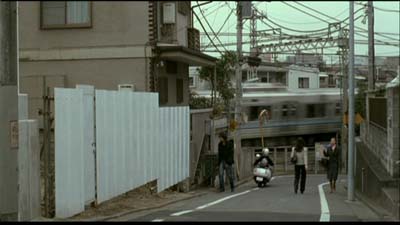
The main protagonists of Tokyo Sonata comprise a “traditional” Japanese family: hard working salary man husband Ryuhei Sasaki (Teruyuki Kagawa), his dutiful, devoted wife Megumi Sasaki (Kyoko Koizumi) and their two sons, ten year oldish Kenji (Inowaki Kai) and teenager Takashi (Yû Koyanagi). Ryuhei becomes a victim of ‘downsizing’ and loses his company job. Rather than let his family know he pretends that nothing has changed and spends his day idling about in the city park or the local library with countless other salary men ‘in between’ jobs, recalling Laurent Cantet’s Time Out (L’Emploi du temps, 2001). Meanwhile, back at home Kenji pines for piano lessons after spotting the young, attractive piano teacher in his neighborhood; Takashi decides to join the US military; and Megumi eats away inside while her family slowly crumbles around her. Ryuhei is reduced to taking up menial jobs (including a lavatory attendant, which must be a veiled homage to Murnau’s The Last Laugh) and tries to hang on to his dignity in the only way he knows how: by enforcing his patriarchal discipline. He refuses to allow Kenji to take up piano lessons and forbids Takashi from joining the US army; but, like everything else, Ryuhei’s authority is undermined (which is one of the other themes of the film, clearly marked in the scene where Kenji embarrasses his school teacher by telling him in front of the class that he saw him reading ‘erotic manga’ on the subway) when Kenji swaps his lunch money for secret lessons and Takashi enlists with his mother’s tacit approval. The gendaigeki portion of the film comes to its dramatic apex in the scene where Ryuhei confronts Kenji over his illicit piano lessons. After Kenji raises his voice, Ryuhei slaps Kenji across the face. An angry Megumi sends Kenji to his room upstairs and tells Ryuhei that she knows he is unemployed (“Screw your authority,” she tells him). Kenji comes back down and throws his cheap Casio (which he found in the garbage) at Ryuhei. Ryuhei chases him up the stairs. We hear Kenji’s off-screen yell and the shot cuts to Kenji falling down the full flight of stairs. He is taken to the hospital, and leaves with only a few cuts and bruises.
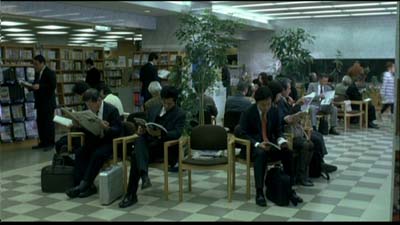
In a paragraph above I qualified the film’s aesthetic by saying that it is a “partial step back” from horror because Kurosawa adopts the same contemplative aesthetic (long takes, little kinetic movement in the frame, actors that move slowly, autumnal lighting, etc.), and by the final act introduces layers of narrative ambiguity that opens the film up to strains of the fantastic. Or if not outright fantastic, a world of ‘what if?’
It is to these ‘strains’ of the possible fantastic that I would like to turn my analysis to in this essay. In particular I would like to focus on a few subtle incursions of unexplained light sourcing through which, I think, Kurosawa interjects the possibility of reading certain narrative moments in the film –such as the happy ending– as being ‘non-realistic’ (i.e. a fantasy, idealisation, dream, or a character’s subjective wish fulfillment).
In Randolph Jordan’s festival report from this same issue he discusses Kurosawa’s use of “absolute silence,” his disjunctive play with light and sound entering into the interior apartment scenes, and the treatment of light, space, and sound in the final recital scene to make a similar point regarding the possibility of the supernatural. I would like to focus on two exterior scenes –to contrast the interior scenes that Randolph discusses– where the appearance of a golden-yellow light into the frame, which is not explained by any apparent diegetic source, casts a mysterious atmosphere onto the scene.
The first example occurs about forty-eight minutes into the film, in the scene where Ryuhei discovers that a high school friend in a similar economic predicament to him, Kurosu (Kanji Tsuda), has committed double suicide with his wife. On the previous day Ryuhei was invited to dinner and met Kurosu’s wife and daughter. He returns to pay them a visit and is told of the tragedy. Ryuhei appears emotionally shocked by the news, perhaps fearing a similar fate for himself. The moment is made strange by three formal factors: a striking edit, the emotional music which abruptly kicks in for the first time in the film, and the incursion of an unexplained light. The disorienting edit comes when Kurosawa cuts from Ryuhei walking quickly out of frame left, to Ryuhei standing deathly still in a different location, staring intently off-screen. The shot cuts to several yards behind Ryuhei to reveal what he is looking at: Kurosu’s daughter, dressed in black, walking across the street toward him. The far camera distance also serves a second function: to frame the odd, yellow-gold flickering light that appears to the extreme right on the bushes behind him and on the back of his black suit. The shot cuts to a reverse high angle behind Ryuhei looking down at the girl, and the same light pattern is visible on the face of Kurosu’s daughter in mourning (see clip below)
I think the strange, unexplained light in this scene (and the blowing wind, a constant intermittent ‘presence’ in the film) announces the coming shift from the opening half’s gendaigeki realism, to the second half’s dream or fantasy-like turn to a series of bizarre events, beginning at about the seventy minute mark of the film.
The strangeness begins with Takashi returning home from military service in his army fatigues and his face sullied, as if coming directly from the battleground, and tells his mother, “I killed so many people. I killed too many.” The scene is played straight but seems off kilter. The sensation is confirmed when Megumi wakes up from a dream. However, it opens up the possibility for the unusual or the improbable turn of events to occur. Ryuhei finds an envelope full of money in the lavatory of the shopping mall where he is working. Megumi is assaulted at home by a hapless thief (played by Kurosawa’s favorite actor, Kôji Yakusho) and then taken hostage because the thief can not drive. They take to the open road in Megumi’s dream car (we see her pretending to be shopping for a similar car at a dealership earlier in the film), ending at the ocean. The scene cuts away on a high angle of a tearful Megumi lying on the sea shore, partly submerged under water. The shot cuts to Kenji being tackled to the ground by two bus station employees, who have caught him trying to grab a free ride by hiding in the luggage compartment of a commercial travel bus. Then we see a beat-up Ryuhei lying on the street in his orange work overalls. Whether meaningful or not, Megumi, Kenji and Ryuhei have each appeared lying on the ground in this sequence. Ryuhei drags himself up off the ground only to become a hit and run victim and left to die by the side of the road. Meanwhile Kenji is arrested, fingerprinted, and put into a holding cell with adult criminals, simply for trying to steal a bus ride. He is then set free the next morning and walks home.
This sequence of bizarre, or at least improbable events comes to an end with an important long take of Megumi alone at the beach. The shot announces the strangeness of the past events, and the improbability of the events to come through its estrangement of real time and use of heightened lighting. The shot begins (at 99’15”) with Megumi in medium long shot. The sky behind her is dark and overcast. Megumi’s eyes are shut, yet she begins to walk, as if sleepwalking. A calm wind stirs both the ocean water behind her up against the shore, and her hair. The camera dollies back as she slowly walks forward. At about 100’00” Megumi stops walking. Her eyes remain shut, but a strange, unsourced (the sun?) yellow-gold light entering from screen right begins to brighten her face. Seconds before the shot ends Megumi opens her eyes to acknowledge the bright light falling on her face (a new dawn?).

The shot then cuts to the same forked road leading to their apartment that we’ve seen countless times before. Megumi appears walking from the left side of the fork, and then the shot cuts to her entering her apartment, casually asking Kenji, seated at the kitchen table, “where’s your father?” Things appear ‘normal’ again, almost as if the odd events from before have not occurred, except for the subtle inclusion of a thermos oddly resting on its side on the table in front of Kenji….a homage to the final table scene in Stalker?
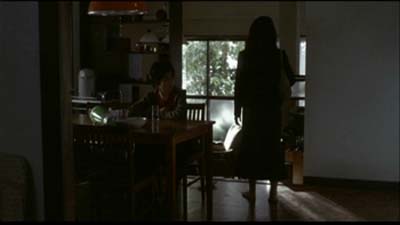
Ryuhei, lying covered in leaves, wakes up from his dead slumber. He puts the money-filled envelope into a mail box and walks home, still dressed in his working class orange overalls. Kenji comments, “You look strange Dad.” They eat a quiet family meal together. Good news comes on the television: there is a pullback of US troops in the Middle East which means that the 3000 international troops, including the 138 Japanese soldiers, will be returning home (pullback of troops in the Middle East, right, maybe that is the most telling clue that we are in fantasy!). Ryuhei, seen diligently scrubbing the shopping mall floor, has seemingly taken to his janitorial work with dedication. Megumi receives a letter from Takashi telling her that he has decided to remain in the US to better acquaint himself with the Americans. This cuts to the final scene of the film, Kenji’s piano recital. Tellingly, Ryuhei is seen for the first time wearing casual clothes. Kenji gives a stirring, perfect performance, reaffirming her teacher’s earlier claim that he is a child prodigy (which Ryuhei cynically shot down as opportunistic lying on the teacher’s part). His playing brings tears to Ryuhei’s eyes. The performance ends. Ryuhei pats Kenji on the head and the two proud parents and Kenji quietly leave the recital hall (symbolically, Kenji and Ryuhei are walking side by side). Is this scene real? Up until this point the film has layered a caustic social critique of Japan’s generational incommunicability, authoritarian patriarchy, and rigid social conformity. All of this seems to have melted away in this final scene. But, has Ryuhei really seen the errors of his past and changed his ways? Has he accepted his lowered social status as a menial worker? Would he be able to afford piano lessons on his reduced wages? Is Kenji a child prodigy? Indeed, is Ryuhei even alive or is he lying dead on the road? Likewise is Megumi alive or is she lying drowned submerged under the incoming tide? These are questions that Kurosawa leaves open for each viewer to ponder.
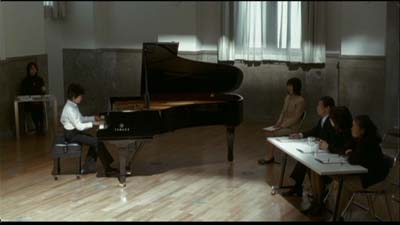
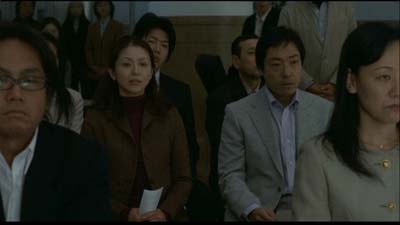
In my reading, I have looked to certain key scenes which, in their stylistic particularities (lighting), suggest that the final scene is, if not real, at least a fantasy, an idealisation, or a hopeful ‘what if’ from the standpoint of a father able to come to terms with Japan’s economic downturn, and accept the next generation’s (and perhaps his wife’s) dreams and aspirations. I have concentrated on the lighting in two key scenes, but this reading (of the characters in search of a fantasy escape) is underscored by dialogue as well. Every character in the film, even minor ones, dreams for change, or for a second chance. A classmate of Kenji wonders out loud, “When’s that giant earthquake coming? The one that’ll turn everything upside down.” Megumi fantasizes that she will wake up to realize that her current life has just been a dream and that her real life will begin. When Ryuhei awakens on the side of the road be begins to cry and mutters to himself, “How can I…start over. How can I…I want to start over. To start over.” In this sense, the ending can be seen as belonging to an alternate life, one where the characters live with humility, mutual respect, and contentment.






